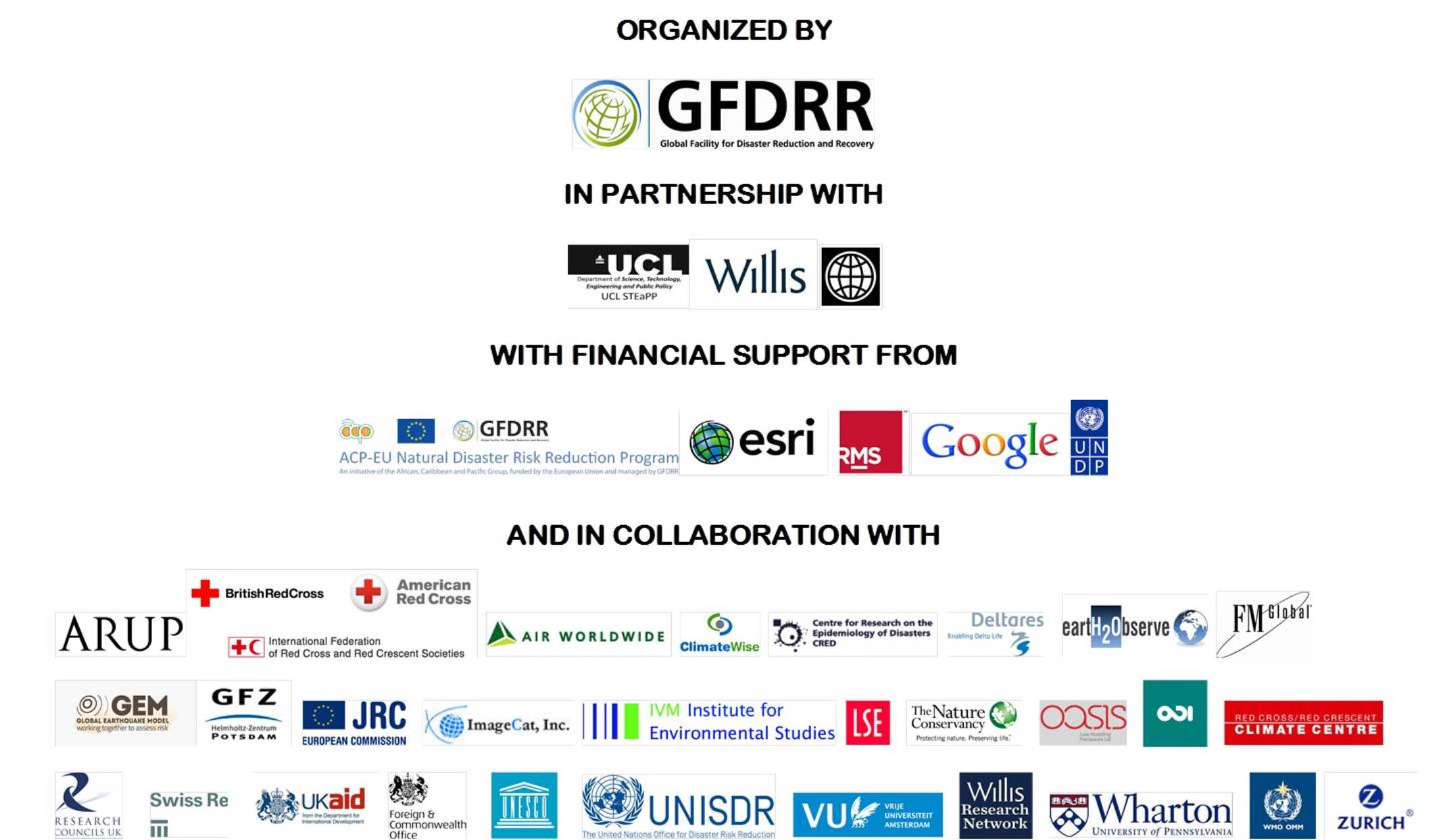Event Summary
Thank you to all who made Understanding Risk 2014 a huge success. Over a period of five days in London, UR2014 convened 840 participants from more than 60 countries, representing 285 institutions that covered government agencies, the private sector, NGOs, research institutions, academia and civil society. The Forum was organized in partnership with Willis, University College London, and the World Bank, with financial support from the Africa, Caribbean and Pacific (ACP) – European Union Disaster Risk Reduction Program, Esri, RMS and Google.
UR2014 hosted a number of dignitaries including the Secretary of Finance for the Philippines, Cesar V. Purisima; Secretary of State for International Development of the UK, Justine Greening; European Commissioner for International Cooperation, Humanitarian Aid and Crisis Response, Kristalina Georgieva; Administrator of the United Nations Development Programme, Helen Clark; and World Bank Group vice president and special envoy for climate change, Rachel Kyte.
Under the theme Producing Actionable Information, 24 technical sessions and workshops led by various international organizations were held, covering topics such as: decision-making under uncertainty, risk modeling in the financial sector, earth observation systems, risk communication, community-based risk assessments, and assessing risk in a changing climate, among others. In addition to the technical sessions, there were 9 plenary events, 24 side workshops and trainings, 2 on-site exhibits, and numerous side meetings and events. The proceedings from UR2014 will be published in fall 2014.
Doubling in attendance size from the last UR Forum held in South Africa, Understanding Risk forums continue to engage the disaster risk community in advancing risk identification, announcing new initiatives, and highlighting areas of the world most at risk of hazards and climate change. Several publications were launched at UR2014, including Understanding Disaster Risk in an Evolving World – Emerging Best Practices in Natural Disaster Risk Assessment and its accompanying Policy Note, Review of Open Source and Open Access Software Packages Available to Quantify Risk from Natural Hazards, and Crowdsourced Geographic Information Use in Government.
UR2014 saw Google and Airbus committing to provide the first global high resolution Digital Elevation Model (DEM) of Earth’s entire land surface, benefitting a multitude of applications including disaster risk identification. RMS announced free access to RMS(one), a risk modeling platform for cat risk, to governments in developing and developed countries. One prominent focus of UR2014 was on Small Island Developing States (SIDS) where a special set of events was organized around financial protection. Many senior leaders from numerous nations participated in these events, including Tonga, Maldives, Grenada, and Madagascar.
Understanding Risk has become the preeminent platform for collaboration, knowledge sharing, and innovation in identifying and assessing disaster risk. We continue to look forward to innovate approaches and successful partnerships from the UR community. Until UR2016!
Event Resources
Event Sessions
- Rome may not have been built in a day, but urban exposure now changes daily – Towards capturing and fusing dynamic information with exposure models through new technology
- Worth your money? – What risk models and economic models tell us about the development impact of insurance and financial protection
- Game over – Exploring the complexity of actionable information through gaming
- Can we determine today, the potential loss of tomorrow and change our future?
- Science and emotion – Acting on risk
- Changing the risk paradigm – Reducing losses and exploiting opportunities
- The power of the crowd – Harnessing communities and opening data
- Can flood resilience be measured? – An innovative, collaborative approach may do just that
- Thinking fast and slow – Why catastrophe risks lead us to behave differently
- Models make markets
- Mission impossible? Using global flood risk assessments for local decision making
- Science, politics and what we value – How big is the risk of climate change?
- The future is not what it used to be – The economic risk of climate change
- Plug and play – Challenges and opportunities for a joined up modeling world
- Big Numbers, Small States – Lessons from the SIDS on risk assessment for financial protection and beyond
- What does it take to build 100 Resilient Cities?
- Back to the future – Innovation in forward looking hazard modeling
- Models as the universal currency for disaster risk financing and management
- Winners and losers – Measuring the impacts and costs of disasters
- Recognize and act upon your risk – Perspectives from chief scientists
- Game of drones – Exploring the potential of drone technology
- UNISDR Global Risk Assessment – Towards an enhanced vision of global disaster risk
- Back to the drawing board – Engineering and planning to manage risk
- Beyond physical risk – Looking through a socio-economic lens
Highlights

